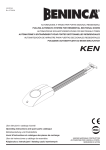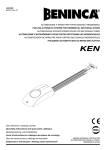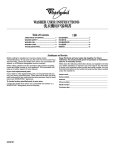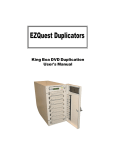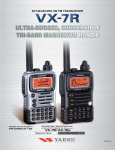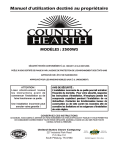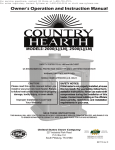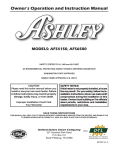Download United States Stove Ashley Heritage 5700 Owner`s manual
Transcript
UNITED STATES STOVE COMPANY “Keeping North America Warm Since 1869” Ashley Heritage MODEL 5700 OWNER’S MANUAL ÌPlease read this entire manual before installation and use of this appliance. Failure to follow these instructions could result in property damage, bodily injury, or even death. ÌContact your local building or fire officials about restrictions and installation inspection requirements in your area. ÌSave these instructions. UNITED STATES STOVE COMPANY 227 INDUSTRIAL PARK ROAD SOUTH PITTSBURG, TENNESSEE 37380 WWW.USSTOVE.COM FOR TECHNICAL ASSISTANCE: -- (800) 750-2723 PHONE: FAX: (423) 837-2109 5700 rev 1 Part No 851606A TABLE OF CONTENTS TABLE OF CONTENTS .................................................................................................................2 SAFETY PRECAUTIONS...............................................................................................................3 SPECIFICATIONS .......................................................................................................................5 Heating Specifications .............................................................................................................5 Dimensions.............................................................................................................................5 Electrical Specifications............................................................................................................5 Fuel Considerations .................................................................................................................5 Safety and EPA Compliance .....................................................................................................5 INSTALLATION ..........................................................................................................................6 Installation Options ................................................................................................................ 6 Floor Protection ..................................................................................................................... 6 Clearances ............................................................................................................................ 7 Venting Requirements .............................................................................................................8 Maximum Venting Distance......................................................................................................8 Pellet Vent Type......................................................................................................................8 Pellet Vent Installation ............................................................................................................8 Pellet Vent Termination ...........................................................................................................8 Vent Termination Clearances ...................................................................................................9 Through the Wall Installation.................................................................................................10 Through the Roof/Ceiling Installation ..................................................................................... 10 Outside Air Supply................................................................................................................. 11 Special Mobile Home Requirements........................................................................................ 12 OPERATION..............................................................................................................................13 How Your Stove Works..........................................................................................................13 Control Panel ........................................................................................................................ 14 Unit Preparation.................................................................................................................... 14 Performing a “Dry Run” ......................................................................................................... 14 Start-Up Procedure ............................................................................................................... 15 Shut Down Procedure............................................................................................................ 15 Daily Operation ..................................................................................................................... 16 Safety and Convenience Features........................................................................................... 16 MAINTENANCE .........................................................................................................................17 Exhaust System .................................................................................................................... 17 Interior Chambers ................................................................................................................. 17 Ash Disposal ......................................................................................................................... 17 Check and Clean the Hopper.................................................................................................. 17 Main Door Gaskets ................................................................................................................ 17 Fan Motors ........................................................................................................................... 17 Painted Surfaces ................................................................................................................... 17 Glass .................................................................................................................................... 18 Fall Start-Up ......................................................................................................................... 18 Spring Shut Down ................................................................................................................. 18 Yearly Servicing .................................................................................................................... 18 TROUBLE SHOOTING ...............................................................................................................20 REPAIR PARTS DIAGRAM ........................................................................................................22 REPAIR PARTS LIST .................................................................................................................23 WIRING DIAGRAM ...................................................................................................................24 FACTORY DEFAULTS.................................................................................................................25 SERVICE RECORD.....................................................................................................................26 -2- SAFETY PRECAUTIONS ÌIMPORTANT: Read this entire manual before ÌDisconnect the power cord before performing installing and operating this product. Failure to do so may result in property damage, bodily injury, or even death. Proper installation of this stove is crucial for safe and efficient operation. any maintenance! NOTE: Turning the ON/OFF Switch to ”OFF” does not disconnect all power to the electrical components of the stove. ÌNever try to repair or replace any part of the stove unless instructions for doing so are given in this manual. All other work should be done by a trained technician. ÌInstall vent at clearances specified by the vent manufacturer. ÌDo not connect the pellet vent to a vent serving ÌAllow the stove to cool before performing any any other appliance or stove. maintenance or cleaning. Ashes must be disposed in a metal container with a tight fitting lid. The closed container of ashes should be placed on a non-combustible surface or on the ground, well away from all combustible materials, pending final disposal. ÌDo not install a flue damper in the exhaust venting system of this unit. ÌUse of outside air is required for this unit. ÌContact your local building officials to obtain a permit and information on any additional installation restrictions or inspection requirements in your area. ÌDo not throw this manual away. This manual ÌThe exhaust system should be checked monthly during the burning season for any build-up of soot or creosote. ÌDo not touch the hot surfaces of the stove. Educate all children on the dangers of a hightemperature stove. Young children should be supervised when they are in the same room as the stove. has important operating and maintenance instructions that you will need at a later time. Always follow the instructions in this manual. ÌThis heater is designed and approved for premium hardwood pellet fuel only. Any other type of fuel burned in this heater will void the warranty and safety listing. ÌNever use gasoline, gasoline-type lantern fuel, kerosene, charcoal lighter fluid, or similar liquids to start or ’freshen up’ a fire in this stove. Keep all such liquids well away from the stove while it is in use. ÌThe hopper and stove top will be hot during operation; therefore, you should always use some type of hand protection when refueling your stove. ÌA power surge protector is required. This unit must be plugged into a 110 - 120V, 60 Hz grounded electrical outlet. Do not use an adapter plug or sever the grounding plug. Do not route the electrical cord underneath, in front of, or over the heater. Do not route the cord in foot traffic areas or pinch the cord under furniture. ÌA working smoke detector must be installed in the same room as this product. ÌThe use of outside air is mandatory for safe operation of this unit. ÌThe heater will not operate during a power outage. If a power outage does occur, check the heater for smoke spillage and open a window if any smoke spills into the room. ÌDo not unplug the stove if you suspect a malfunction. Turn the ON/OFF SWITCH to ”OFF’ and contact your dealer. ÌThe feed door, hopper lid, and ash pan must be closed and sealed during operation. ÌYour stove requires periodic maintenance and cleaning (see ”MAINTENANCE ”). Failure to maintain your stove may lead to improper and/or unsafe operation. ÌNever block free airflow through the open vents of the unit. -3- SAFETY PRECAUTIONS ÌKeep foreign objects out of the hopper. ÌThe moving parts of this stove are propelled by high torque electric motors. Keep all body parts away from the auger while the stove is plugged into an electrical outlet. These moving parts may begin to move at any time while the stove is plugged in. ÌDo not place clothing or other flammable items on or near this stove. ÌWhen installed in a mobile home, the stove must be grounded directly to the steel chassis and bolted to the floor. WARNING—THIS UNIT MUST NOT BE INSTALLED IN THE BEDROOM (per HUD requirements). CAUTION— THE STRUCTURAL INTEGRITY OF THE MOBILE HOME FLOOR, WALL, AND CEILING/ROOF MUST BE MAINTAINED. ÌThis appliance is not intended for commercial use. Note: United States Stove Company grants no warranty, implied or stated, for the installation or maintenance of your stove, and assumes no responsibility of any consequential damage(s). -4- SPECIFICATIONS HEATING SPECIFICATIONS Heat Output1 38,000 BTU/hr Heating Capacity2 800 – 2,000 sq ft Fuel Burn Rate3 1.5 – 4.7 lbs/hr Burn Time (lowest setting) 24 hrs Hopper Capacity 50 lbs 1 BTU output will vary depending on the quality of fuel. Use PFI listed fuels for the best results. 2 Heating capacity will vary depending on floor plan layout of your home, degree of insulation, and the outside temperature. 3 Pellet size may effect the actual rate of fuel feed and burn times. Fuel feed rates may vary by as much as 20%. Use PFI listed fuel for best results. DIMENSIONS Height 38 3/4 in Width 24 1/4 in Depth 25 3/4 in Weight (empty) 280 lbs ELECTRICAL SPECIFICATIONS Electrical Rating 110-120 volts 60 HZ 3.0 amps Watts (operational) 175 (approximately) Watts (igniter running) 425 (approximately) FUEL CONSIDERATIONS Your Ashley Heritage Model 5700 stove is designed to burn premium hardwood pellets that comply with Associa- tion of Pellet Fuel Industries standards. (Minimum of 40 lbs density per cubic ft, 1/4” to 5/16” diameter, length no greater than 1.5”, not less than 8,200 BTU/lb, moisture under 8% by weight, ash under 1% by weight, and salt under 300 parts per million). Pellets that are soft, contain excessive amounts of loose sawdust, have been, or are wet, will result in reduced performance. SAFETY AND EPA COMPLIANCE Your Ashley Heritage Model 5700 stove has been safety tested and listed to ASTM E 1509, (UM) 84-HUD by OMNI-Test Laboratories, Inc. Beaverton, Oregon, USA. It is also exempt from EPA Phase II requirements. -5- INSTALLATION INSTALLATION OPTIONS ÌRead this entire manual before you install and use your Ashley Heritage stove. Failure to follow instructions may result in property damage, bodily injury, or even death! (See specific installation details for clearances and other installation requirements) A Freestanding Unit—supported by (4) legs and placed on a non-combustible floor surface in compliance with clearance requirements for a freestanding stove installation. An Alcove Unit—supported by (4) legs and placed on a non-combustible floor surface in compliance with clearance requirements for an alcove installation. Your Ashley Heritage Model 5700 stove may be installed to code in either a conventional or mobile home (see SPECIAL MOBILE HOME REQUIREMENTS). It is recommended that only a authorized technician install your Ashley Heritage stove, preferably an NFI certified specialist. IMPROPER INSTALLATION: The manufacturer will not be held responsible for damage caused by the malfunction of a stove due to improper venting or installation. Call (800) 750-2723 and/or consult a professional installer if you have any questions. FLOOR PROTECTION This unit must be installed on a non-combustible floor surface. If a floor pad is used, it should be UL listed or equal. The floor pad or non-combustible surface should be large enough to extend a minimum of 6-inches in front, 6inches on each side, and 1-inch behind the stove (see FIGURE 1). Floor protection must extend under and 2-inches to each side of the chimney tee for an interior vertical installation (see FIGURE 2). Your Ashley Heritage Model 5700 stove will need a minimum 36 1/4” x 30 3/8” floor protector. FIGURE 1 THROUGH THE WALL INSTALLATION FIGURE 2 CLEARANCES -6- INTERIOR VERTICAL INSTALLATION INSTALLATION Your Ashley Heritage Model 5700 stove has been tested and listed for installation in residential, mobile home, and alcove applications in accordance with the clearances given in FIGURES 3-5 and TABLE 1. NOTE: Distance “C” on the right-hand side of your Ashley Heritage Model 5700 stove may need to be greater than the minimum required clearance for suitable access to the control panel. FIGURE 3 FIGURE 4 SIDEWALL CLEARANCES PARALLEL INSTALLATION SIDEWALL CLEARANCES CORNER INSTALLATION A—BACKWALL TO UNIT 3 IN / 75 MM B—SIDEWALL TO FLUE 12 IN / 305 MM C—SIDEWALL TO TOP EDGE OF UNIT 10 IN / 254 MM CORNER D—ADJACENT WALL TO UNIT 10 IN / 254 MM ALCOVE E—ALCOVE DEPTH 36 IN / 914 MM F—ALCOVE HEIGHT 60 IN / 1520 MM PARALLEL TABLE 1 CLEARANCES FIGURE 5 ALCOVE CLEARANCES VENTING REQUIREMENTS -7- INSTALLATION ÌInstall vent at clearances specified by the vent manufacturer. ÌDo not connect the pellet vent to a vent serving any other appliance or stove. ÌDo not install a flue damper in the exhaust venting system of this unit. The following installation guidelines must be followed to ensure conformity with both the safety listing of this stove and to local building codes. IMPORTANT! This unit is equipped with a negative draft system that pulls air through the burn pot and pushes the exhaust out of the dwelling. If this unit is connected to a flue system other than the way explained in this manual, it will not function properly. MAXIMUM VENTING DISTANCE Installation MUST include at least 3-feet of vertical pipe. This will create some natural draft to reduce the possibility of smoke or odor during appliance shutdown and keep exhaust from causing a nuisance or hazard by exposing people or shrubs to high temperatures. The maximum recommend vertical venting height is 12-feet for 3-inch type “PL” vent. Total length of horizontal vent MUST NOT exceed 4-feet. Use no more than 180 degrees of elbows (two 90-degree elbows, or two 45-degree and one 90-degree elbow, etc.) to maintain adequate draft. PELLET VENT TYPE A UL listed 3-inch or 4-inch type “PL” pellet vent exhaust system must be used for installation and attached to the pipe connector provided on the back of the stove (use a 3-inch to 4-inch adapter for 4-inch pipe). Use 4-inch vent if the vent height is over 12-feet or if the installation is over 2,500 feet above sea level. We recommend the use of Simpson Dura-Vent® or Metal-Fab® pipe (if you use other pipe, consult your local building codes and/or building inspectors). Do not use Type-B Gas Vent pipe or galvanized pipe with this unit. The pellet vent pipe is designed to disassemble for cleaning and should be checked several times during the burning season. Pellet vent pipe is not furnished with the unit and must be purchased separately. PELLET VENT INSTALLATION The installation must include a clean-out tee to enable collection of fly ash and to permit periodic cleaning of the exhaust system. 90-degree elbows accumulate fly ash and soot thereby reducing exhaust flow and performance of the stove. Each elbow or tee reduces draft potential by 30% to 50%. All joints in the vent system must be fastened by at least 3 screws, and all joints must be sealed with HI-TEMP RTV silicone sealant to be airtight. The area where the vent pipe penetrates to the exterior of the home must be sealed with silicone or other means to maintain the vapor barrier between the exterior and the interior of the home. Vent surfaces can get hot enough to cause burns if touched by children. Noncombustible shielding or guards may be required. PELLET VENT TERMINATION Do not terminate the vent in an enclosed or semi-enclosed area, such as; carport, garage, attic, crawl space, under a sundeck or porch, narrow walkway, or any other location that can build up a concentration of fumes. The termination must exhaust above the outside air inlet elevation. The termination must not be located where it will become plugged by snow or other materials. -8- INSTALLATION VENT TERMINATION CLEARANCES: A) B) C) D) E) F) G) H) I) Minimum 4-foot clearance below or beside any door or window that opens. Minimum 1-foot clearance above any door or window that opens. Minimum 3-foot clearance form any adjacent building. Minimum 7-foot clearance from any grade when adjacent to public walkways. Minimum 2-foot clearance above any grass, plants, or other combustible materials. Minimum 3-foot clearance from an forced air intake of any appliance. Minimum 2-foot clearance below eves or overhang. Minimum 1-foot clearance horizontally from combustible wall. Must be a minimum of 36-inches above the roof and 24-inches above the highest point or the roof within 10feet. I A F B C H D F A E FIGURE 6 VENT TERMINATION CLEARANCES -9- INSTALLATION THROUGH THE WALL INSTALLATION (RECOMMENDED INSTALLATION) To vent the unit through the wall, connect the pipe adapter to the exhaust motor adapter. If the exhaust adapter is at least 18-inches above ground level, a straight section of pellet vent pipe can be used through the wall. Your Ashley Heritage dealer should be able to provide you with a kit that will handle most of this installation, which will include a wall thimble that will allow the proper clearance through a combustible wall. Once outside the structure, a 3-inch clearance should be maintained from the outside wall and a clean out tee should be placed on the pipe with a 90-degree turn away from the house. At this point, a 3-foot (minimum) section of pipe should be added with a horizontal cap, which would complete the installation (see FIGURE 7). A support bracket should be placed just below the termination cap or one every 4-feet to make the system more stable. If you live in an area that has heavy snowfall, it is recommended that the installation be taller than 3-feet to get above the snowdrift line. This same installation can be used if your stove is below ground level by simply adding the clean-out section and vertical pipe inside until ground level is reached. With this installation you have to be aware of the snowdrift line, dead grass, and leaves. We recommend a 3-foot minimum vertical rise on the inside or outside of the house. FIGURE 7 TYPICAL THROUGH THE WALL INSTALLATION The “through the wall” installation is the least expensive and simplest installation. Never terminate the end vent under a deck, in an alcove, under a window, or between two windows. We recommend Simpson Dura-Vent® or Metal-Fab® kits. THROUGH THE ROOF/CEILING INSTALLATION When venting the stove through the ceiling, the pipe is connected the same as through the wall, except the cleanout tee is always on the inside of the house, and a 3-inch adapter is added before the clean-out tee. You must use the proper ceiling support flanges and roof flashing (supplied by the pipe manufacturer; follow the pipe manufacturer’s directions). It is important to note that if your vertical run of pipe is more than 15-feet, the pellet vent pipe size should be increased to 4-inches in diameter. Do not exceed more than 4-feet of pipe on a horizontal run and use as few elbows as possible. If an offset is required, it is better to install 45-degree elbows rather than 90-degree elbows. -10- INSTALLATION OUTSIDE AIR SUPPLY ÌThe use of outside air is mandatory for safe operation of this unit. For all installations it is mandatory that this unit be connected to an outside air supply . Metal pipe (solid or flexible) must be used for the outside air installation. PVC pipe is NOT approved and should NEVER be used. A wind shield over the termination of the outside air pipe or a 90-degree elbow or bend away from the prevailing winds MUST be used when an outside air pipe is installed through the side of a building. The outside air termination MUST be at least 1-foot away from the exhaust system termination. The outside air pipe on your Ashley Heritage Model 5700 stove is 1 7/8” OD. The outside air connecting pipe must be at least 1 7/8” ID. The outside air connection used MUST NOT restrict the amount of air available to your stove. The outside air connecting pipe must be as short and free of bends as possible, and it must fit over, not inside, the outside air connection to the stove (USSC Part No FAK1780 Fresh Air Kit is recommended). WIND HOOD 1 7/8” ID 2” MIN WIRE MESH SCREEN FIGURE 9 TYPICAL OUTSIDE AIR TERMINATION FIGURE 8 EXHAUST/INLET LOCATIONS NOTE: Dimensions from the floor to your stoves inlet/exhaust pipes are approximate and may vary depending on your installation. -11- INSTALLATION SPECIAL MOBILE HOME REQUIREMENTS ÌWARNING! - DO NOT INSTALL IN A SLEEPING ROOM ÌCAUTION! - THE STRUCTURAL INTEGRITY OF THE MOBILE HOME FLOOR, WALL, AND CEILING/ ROOF MUST BE MAINTAINED. In addition to the previously detailed installation requirements, mobile home installations must meet the following requirements: •The stove must be permanently attached to the floor. •The stove must have a permanent outside air source (USSC Part No FAK1780 Fresh Air Kit is recommended). •The stove must be electrically grounded to the steel chassis of the mobile home with 8 GA copper wire using a serrated or star washer to penetrate paint or protective coating to ensure grounding. •Vent must be 3 or 4-inch “PL” Vent and must extend a minimum or 36-inches above the roofline of the mobile home and must be installed using a UL/ULC listed ceiling fire stop and rain cap. •When moving your mobile home, all exterior venting must be removed while the mobile home is being relocated. After relocation, all venting must be reinstalled and securely fastened. •Check with your local building officials as other codes may apply. -12- OPERATION ÌDo not operate your stove with the viewing or ash pan doors open. The upper auger will not feed pellets under these circumstances and a safety concern may arise from sparks or fumes entering the room. ÌThis heater is designed and approved for premium hardwood pellet fuel only. Any other type of fuel burned in this heater will void the warranty and safety listing. ÌA working smoke detector must be installed in the same room as this product. HOW YOUR STOVE WORKS Your Ashley Heritage Model 5700 stove utilizes a dual au- ger fuel feed system that is operated by a microprocessor controlled digital circuit board. The digital circuit board allows the dual auger fuel feed system to run in a timer-based, noncontinuous cycle; this cycling allows the top auger to run for a predetermined period of seconds, while the bottom auger operates continuously. The top auger drops pellets to the bottom auger, while the bottom auger pushes the pellets forward to the burn pot. As pellets enter the burn pot, outside air is drawn across the fuel and heated during the combustion process. This heated combustion air is then pulled through the heat exchanger by the exhaust blower, where it is used to heat air that is drawn into the heat exchanger system by the room air fan (see FIGURE 10). Because a forced draft pressure is required for the combustion process inside your stove, it is extremely important that the exhaust system be properly installed and maintained. And, that when operating your stove, you make sure that the hopper lid, door, and ash pan slides are all properly sealed. Your stove’s heat output can vary from hi to low by adjusting the settings on the control panel (located on the lower righthand side of the stove). The “HEAT RANGE” setting will vary FIGURE 10 the auger systems feed rate and the exhaust blower speed (i.e. HOW YOUR STOVE WORKS combustion air). The “BLOWER SPEED” setting will adjust the room air fan speed (i.e. convection air). Each setting has a range of 1 to 9 (lowest to highest). Any combination of “HEAT RANGE” and “BLOWER SPEED” can be used during the operation of your stove. Your stove can run efficiently over extended periods of time and at different heat output levels as long as the fuel supply is uninterrupted and proper cleaning and maintenance is performed. (NOTE: Operating your stove on a high “HEAT RANGE” setting and a low “BLOWER SPEED” setting for extended periods of time may cause your stove to reach an over-temperature condition, in which case, the stove will automatically reduce the fuel feed rate and/or increase the room air fan speed. This is a safety precaution that has been designed into your stove and is not a malfunction). -13- OPERATION CONTROL PANEL Turning the stove OFF/ON, as well as adjustments for the fuel feed rate and room air fan speed are performed by pressing the appropriate button(s) on the control panel which is located on the lower right-hand side of your Ashley Heritage Model 5700 stove (see FIGURE 11). Pressing the “ON” button on the control panel will begin the start-up sequence for the stove. Fuel will begin to feed through the auger feed system and, once an adequate amount of fuel has been deposited into the burn pot, the auto-start igniter will ignite the fuel. Pressing the up/down arrow buttons beneath the “HEAT RANGE” and “BLOWER SPEED” will adjust the amount of fuel that is fed to the burn pot and the amount of room air drawn through the stove to be heated, respectively. Either value can be set from 1 to 9 (lowest to highest). FIGURE 11 DIGITAL CONTROL PANEL Pressing the “OFF” button on the control panel will cause the stove to enter its shut-down sequence. The fuel feed system will stop pulling fuel from the hopper and, once the fire goes out and the stove cools down, the lower auger and all of the blowers will stop running. The “A”, “B”, and “C” buttons on the control panel are reserved for diagnostic use only. These controls are disabled by default when the unit is shipped from our factory. UNIT PREPARATION After carefully unpacking and reading the instructions for installing your stove, you will need to perform the following steps: 1) Attach the two (2) included spring handles; one (1) for the door handle and (1) ash pan slide lever by screwing them on in their respective locations. 2) Adjust the legs as necessary so that the stove is sitting level on the floor. 3) Locate and attach the firewall impingement plate inside the stove (see FIGURE 12). 4) Attach the electrical cord to the back of the stove first; then plug it into a 110-volt outlet (an outlet surge protector is highly recommended). 5) Check that the hopper lid latch is properly adjusted so as to create a tight fit between the hopper lid and hopper. Important: Hopper Lid Latch must be tight so that the hopper is sealed airtight while the stove is operating, failure to do so may result in a hopper fire. PERFORMING A “DRY RUN” Perform a “dry run” on your stove prior to making the exhaust/inlet connections and starting your stove for the first time. 1) Check that there is NO fuel in the hopper or burn-pot. 2) Check that the hopper lid, viewing door, and ash pan slides are securely closed. 3) Press the “ON” button on the control panel. This will start the upper auger, bottom auger, and exhaust blower. -14- OPERATION 4) Check that both augers and the exhaust blower are operating (the room air blower will not start at this time). DO NOT open the viewing door, the auto-start igniter will get very hot during this test. The stove will automatically shut down after approximately 23 minutes. START-UP PROCEDURE ÌNever use gasoline, gasoline-type lantern fuel, kerosene, charcoal lighter fluid, or similar liquids to start or ’freshen up’ a fire in this stove. Keep all such liquids well away from the stove while it is in use. 1) Verify that the hopper is clean and free of foreign matter. 2) Verify that all of the required exhaust/inlet connections have been made in accordance with this manual and that the stove is plugged into an outlet (an outlet surge protector is highly recommended). 3) Fill the hopper with wood pellets; do not allow any part of the bag or any other foreign material into the hopper, as this may jam the augers. 4) Ensure that all pellet matter is cleared from the hopper gasket seating surface. 5) Close the hopper lid and secure the latch. 6) Make sure that the viewing door and ash pan slides are securely closed (the safety pressure switch will not allow the stove to feed fuel if there is no draft pressure inside the stove) . 7) Press the “ON” button on the control pad and set the “HEAT SETTING” to “5”. 8) The stove will begin to feed fuel and the auto-start igniter will ignite the fuel in approximately 5 minutes. Once a consistent flame has been established, you can adjust the “HEAT RANGE” and “BLOWER SPEED” on the control pad to your desired settings. (Note: The room air fan will not function until the heat exchanger in the stove reaches the factory preset temperature). First Fire: Adjust the “HEAT RANGE” and “BLOWER SPEED” to a “5” setting and allow the stove to operate in this manner for approximately three (3) hours (or more if necessary), allowing the stove to “cure out” as the paint and oils from the manufacturing process burn off. We recommend that you open doors and windows in your home during this process. SHUT DOWN PROCEDURE WARNING: Never shut down this unit by unplugging it from the power source. Press the “OFF” button on the control pad to put the stove in shut down mode. At this time, the red light above the pad will illuminate. Once this is done, the top auger will stop feeding pellets to the bottom auger, but the room air fan, exhaust blower, and bottom auger will continue to operate. When the internal temperature of the unit drops below the factory preset temperature, the room air fan, exhaust blower, and bottom auger will cease to operate. The red light will then shut off and the unit will be completely shut down. The hotter the unit is during its operation, the longer it will take for the stove to complete the shut down cycle. If the stove stays on for more than 2 hours after pressing the “OFF” button and you are sure that the fire is out, the stove can be unplugged from the outlet. After approximately 10 seconds, the unit can be re-connected to the power source and the control board will be reset. -15- OPERATION DAILY OPERATION ÌThe hopper and stove top will be hot during operation; therefore, you should always use some type of hand protection when refueling your stove. ÌNever place your hand near the auger while the stove is in operation. This unit has a 50-pound hopper and should be filled when the hopper level drops below 3-inches. Ensure that all pellet matter is cleared from the hopper gasket surface before closing. Be sure to close hopper securely after refueling. Do not operate this unit with the hopper lid open or unsecured. In the event of a power outage, the stove WILL NOT function. It is very important that unit be vented properly (with outside air), as the natural draft is needed to clear the smoke from the stove during a power outage. Also, DO NOT open the hopper lid because this may allow fire to burn-back into the hopper. If the unit was “ON” when the power outage occured, one of the following will take place: 1) If the stove is still warm, it will resume feeding fuel and continue to operate normally. If the fire has gone out, you will have to press the “OFF” button and then the “ON” button again to begin a new start-up sequence. 2) If the stove has cooled-off, it will reset to its “OFF” condition. At this point, you may press the “ON” button and the unit will begin a new start-up sequence. NOTE: The unit will also shut down in the event of an exhaust blower failure; if this is the case, the unit will not restart and you must contact Customer Service at (800) 750-2723. SAFETY AND CONVENIENCE FEATURES Your Ashley Heritage Model 5700 incorporates a safety pressure switch that helps ensure that everything is in proper working order before feeding fuel to the burn pot. Because the stove works using an induced draft pressure, the stove will not continue to operate if the viewing door or ash pan slides are left open; or if the combustion blower fails or the exhaust system is blocked. The temperature limit control will prevent your stove from operating at abnormally high temperatures. Should the stove temperature begin to approach the factory pre-set limit, the temperature limit control will automatically slow down the auger feed rate until the temperature returns to a normal condition. Your Ashley Heritage Model 5700 stove also includes an auto-start igniter as a standard feature. The use of other fire starter materials (wood chips, starter gel, etc.) is not necessary. By simply pressing the “ON” button on the digital control panel, your stove will begin to feed fuel and automatically start within 5 minutes. Additionally, your Ashley Heritage Model 5700 stove includes an integral ash pan, making the cleaning and removal of ash less frequent and more convenient -16- MAINTENANCE ÌFailure to clean and maintain this unit as indicated can result in poor performance and safety hazards. ÌUnplug your stove’s electrical cord prior to removing the back panel or opening the exhaust system for any inspection, cleaning, or maintenance work. ÌNever perform any inspections, cleaning, or maintenance on a hot stove. ÌDo not operate stove with broken glass , leakage of flue gas may result. EXHAUST SYSTEM The by products of combustion contain small particles of fly ash. Fly ash will collect in the exhaust venting system and restrict the flow of flue gases. Incomplete combustion, such as during startup, shutdown, or incorrect operation of the stove will lead to soot formation which will collect in the exhaust system. Therefore, it is important that the exhaust system be inspected and cleaned at least monthly during the burning season. Check the clean out tees periodically to determine the required cleaning schedule. 3 or 4-inch chimney brushes are available for chimney cleaning. If the exhaust system or outside air pipes have screens on them, frequently clean the screen. A plugged screen will shut off combustion air and cause a fire to die or burn poorly. INTERIOR CHAMBERS Periodically remove and clean the burn plate and the area inside the burn pot. In particular it is advisable to clean out the holes in the burn plate to remove any build up that may prevent air from moving through the burn pot freely. When replacing the burn plate, be sure that it is properly seated in the burn pot. (NOTE: It is not necessary to remove the burn pot for normal cleaning, if you do, you MUST replace the gasket that goes between the burn pot and firewall.) Remove the firewall impingement plate and clean any ash that may have collected in the heat exchanger system. If a vacuum is used to clean your stove, we suggest using a vacuum designed for ash removal. Some regular vacuum cleaner (i.e. shop vacs) may leak ash into the room. ASH DISPOSAL Remove the ash pan and dump the ash as needed. (NOTE: Ashes should be placed in a metal container with a tight fitting lid. Place the container on a non-combustible surface well away from all combustible materials. Retain all ash material in the container until all cinders have thoroughly cooled.) CHECK AND CLEAN THE HOPPER Check the hopper periodically to determine if there is any sawdust or pellets that are sticking to the hopper surface. Clean as needed. MAIN DOOR GASKETS Inspect the main door and glass window gaskets periodically. The main door may need to be removed to have frayed, broken, or compacted gaskets replaced by your Authorized “Ashley Heritage” Dealer. FAN MOTORS Clean the air holes on the motors of both the exhaust and room air fans annually. Remove the exhaust blower from the exhaust duct and clean out the internal fan blades as part of your fall start-up. PAINTED SURFACES Painted surfaces may be wiped down with a damp cloth. If scratches appear, or you wish to renew your paint, con-17- MAINTENANCE tact your Authorized “Ashley Heritage” Dealer to obtain a can of suitable high-temperature paint. GLASS We recommend using a high quality glass cleaner. Should a build up of creosote or carbon accumulate, you may wish to use 000 steel wool and water to clean the glass. In the event you need to replace the glass, only high temperature ceramic glass of the correct size and thickness may be used. Contact your Authorized “Ashley Heritage” Dealer to obtain this glass. FALL START UP Prior to starting the first fire of the heating season, check the outside area around the exhaust and air intake systems for obstructions. Clean and remove any fly ash from the exhaust venting system. Clean any screens on the exhaust system and on the outside air intake pipe. Turn all of the controls on and make sure that they are working properly. This is also a good time to give the entire stove a good cleaning throughout. SPRING SHUTDOWN After the last burn in the spring, remove any remaining pellets from the hopper and the auger feed system. Scoop out the pellets and then run the auger until the hopper is empty and pellets stop flowing (this can be done by pressing the “ON” button with the viewing door open). Vacuum out the hopper. Thoroughly clean the burn grate, firebox, ash pan and ash traps. It may be desirable to spray the inside of the cleaned hopper with an aerosol silicone spray if your stove is in a high humidity area. The exhaust system should be thoroughly cleaned. YEARLY SERVICING A yearly servicing and cleaning by your Authorized “Ashley Heritage” Dealer is recommended. A fee may be charged for this service. -18- MAINTENANCE FIGURE 12 MAINTENANCE PARTS DIAGRAM -19- TROUBLE SHOOTING ÌDisconnect the power cord before performing any maintenance! NOTE: Turning the ON/OFF Switch to ”OFF” does not disconnect all power to the electrical components of the stove. ÌNever try to repair or replace any part of the stove unless instructions for doing so are given in this manual. All other work should be done by a trained technician. PROBLEM CAUSE: Too rich air/fuel mixture Orange, lazy flame—excessive •Clean out the burn plate and burn pot. fuel build-up in the burn pot •Check that the ash pan slides are completely closed. •Make sure that the viewing door is shut and sealed tightly. If not, adjust the door catch and/or replace the gaskets. •Check that the outside air connection is clear of any obstructions. •Check that the hopper lid is sealed tightly. •Check the exhaust system, clean as needed. PROBLEM CAUSE: Firepot burns out of fuel Fire goes out or stove shuts •Hopper is empty, refill the hopper. down. Lower auger turns, but •Loss of draft pressure. Check that the main door, ash pan slides, and hopper lid are no fuel is feeding. all sealed tightly. Check that the outside air connection is clean and clear of any obstructions. Check the exhaust system, clean as needed. •Auger system is jammed or there is “bridging” of the fuel in the hopper, preventing fuel from flowing into the auger feed system. PROBLEM CAUSE: Auto-Start Igniter fails to ignite the fuel in the burn pot Stove does not start a fire •Turn the stove “OFF”. Clear the unspent fuel from the burn pot and try again. when “ON” button is pushed. •Check the pellet quality. Replace if moist, wet, or dirty. •Loss of draft pressure. Check that the main door, ash pan slides, and hopper lid are all sealed tightly. Check that the outside air connection is clean and clear of any obstructions. Check the exhaust system, clean as needed. The safety pressure switch will not supply power to the auto-start igniter if there isn’t sufficient draft pressure inside the stove. •Check that the auto-start igniter is not blocked with ash or soot (the igniter is located behind the 3/8” diameter hole located on the back wall of the burn pot). NOTE: The gasket between the burn pot and rear firewall is critical for the flow of hot air from the auto-start igniter into the burn pot. If you have previously removed the burn pot, this gasket must be replaced. •The Auto-Start Igniter gets “red hot” during start-up. If you can not visibly see the igniter glowing during start-up, then the auto-start igniter may need to be replaced or there is a problem with the electrical control system. -20- TROUBLE SHOOTING -21- REPAIR PARTS DIAGRAM—MODEL 5700 -22- REPAIR PARTS LIST—MODEL 5700 ITEM PART NO. DESCRIPTION ITEM PART NO. 1 69465B Main Weldment 23 40488 DESCRIPTION Auger Housing 2 69461 Impingement Plate Weldment 24 40489 Auger, Short 3 69462 Ash Dump Weldment 25 40490 Auger, Long 4 25361 Guide, Ash Dump Rod 26 88101 Gasket, Mounted Bearing 5 89954 Spring Handle 27 891105 Mounted Bearing 6 69466 Hopper Weldment 28 25370 Stop, Auger Motor 7 88110 Gasket, Hopper Bottom 29 891117 Shaft Collar, 3/4" ID 8 69463B Ash Pan Weldment 30 83045 Washer 9 89899 Knob 31 83337 5/16-18 x 1-1/4 Bolt 10 891122 Burnpot Weldment 32 80474 Auger Motor 11 88102 Gasket, Burnpot 33 86613 Air Intake Tube 12 25355 Burn Plate 34 80481 Ignitor Cartridge 13 83475 5/16-18 x 1-3/4 Bolt 35 80472 Blower, Distribution 14 25080B Latch, Door 36 88106 Gasket, Distribution Blower 15 69467 Feed Door Assembly 37 88107 Insulation, Exhaust Chute 15.1 25266 Feed Door 38 80473 Blower, Exhaust 15.2 891067 Door Glass w/Ashley Logo 39 88100 Gasket, Exhaust Blower 15.3 88087 Glass Gasket (1 x 3/16) 40 25377B Blower Access Cover 15.4 25393 Glass Retainer 41 80478 Pressure Switch 15.5 88066 5/8 Rope Gasket 42 891121 Silicone Tube 15.6 25452 Handle, Door 43 89586 Auger Nipple 15.7 83506 3/8 x 1-1/4 Roll Pin 44 25344B Back, Cabinet 15.8 89574 Handle, Brass Spring 45 80462 Recepticle, 3 Prong 16 69464B Cabinet Top-Front Weldment 46 80461 Power Supply Cord 17 69471B Cabinet Top-Lid Weldment 18 88109 Seal, Hopper Lid 19 891125 Latch, Hopper Lid 20 80475 Circuit Board Assembly 21 80480 Temperature Sensor 22 83524 5/16-18 x 1 Flat Head Socket Cap Screw HOW TO ORDER REPAIR PARTS When inquiring about spare parts, always give the full model number which is on the nameplate attached to the back of the unit. The following information is needed when ordering spare parts: 1) Part Number: 2) Part Description: 3) Model Number: 5700 4) Serial Number: United States Stove Company 227 Industrial Park Road PO Box 151 South Pittsburg, TN 37380 (888) 299-1440 (Parts Department) www.usstove.com -23- WIRING DIAGRAM -24- FACTORY DEFAULTS FACTORY DEFAULT SETTINGS Setting Description Default Value (P1) Auger Period Time limit for the upper auger period of operation. Display in is 1/10th sec. 16 sec (P2) Cold Stove Temp Low temperature limit that a warm stove must reach in order to shut down completely. 95 deg F (P3) Hot Stove Temp Maximum temperature limit that the stove is allowed to reach before ceasing to feed fuel. 350 deg F (P4) Hot Stove Hysterisis Temperature differential below the Hot Stove Temp that the stove must reach before resuming operation. 1 deg F (P5) Room Air On Temp Minimum temperature that the stove must reach before the room air fan will operate. 115 deg F (P6) Auger Load Time Time limit that the auger will feed fuel dur- 15 sec ing the start-up sequence prior to engaging the automatic igniter. (P7) Igniter On Time Time limit that the automatic igniter is engaged during the start-up sequence. 8 min (P8) Start-Up Time Time limit that the stove will be allowed to operate before the Room Air On Temp must be reached. 15 min (P9) Factory Defaults Selecting this variable will reset all of the variables to the factory defaults. - (PA) Room Fan On Temp High temperature limit that will cause the stove to reduce the fuel feed rate by 25% and maximize the room air fan speed. 290 deg (PB) Auger Start Operation Variable to control the auger fuel feed dur- 0 ing start-up. (0 = On, 1 = Off). (PC) Auger Operation Select Variable to set the upper auger period of operation. (0 = 4 sec, 1 = 6 sec) -25- 1 SERVICE RECORD DATE SERVICE OR CLEANING PERFORMED -26- -27- UNITED STATES STOVE COMPANY 227 INDUSTRIAL PARK ROAD PO BOX 151 SOUTH PITTSBURG, TN 37380 (800) 750-2723 WWW.USSTOVE.COM -28-





























